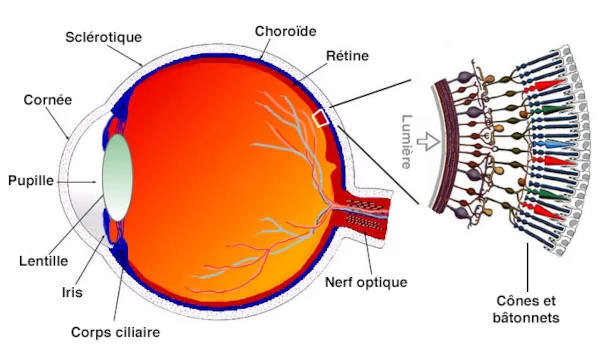
Image description: Color is a fascinating phenomenon originating from the interaction of light with objects. Mixing primary colors by addition (left image). Mixing primary colors by subtraction (right image). Primary and secondary colors are specific to each additive or subtractive model.
The additive and subtractive color models differ in the way light interacts with objects, particularly with regard to refraction and absorption of light.
The Additive Model relates to light emitted by objects and the refraction of light entering our eyes. Refraction is the change in the direction of light as it passes from one medium to another. This model concerns the blending of different colors of light to create perceived colors. The three primary colors in the additive color model are Red, Green, and Blue. When primary colors are mixed, they produce the secondary colors Yellow (Red + Green), Cyan (Green + Blue), Magenta (Red + Blue), White (Red + Green + Blue), as shown in the left image.
The Subtractive Model relates to light absorbed by objects. Colored objects absorb certain light wavelengths and reflect others. The color of an object is determined by the wavelengths of light it does not absorb, meaning those it reflects. For example, an object that appears blue mainly absorbs red and green wavelengths while reflecting blue wavelengths. The three primary colors in the subtractive color model are Cyan, Magenta, and Yellow. When primary colors are mixed, they produce the secondary colors Blue (Cyan + Magenta), Green (Cyan + Yellow), Red (Magenta + Yellow), Black (Cyan + Magenta + Yellow), as shown in the right image.

Image description: Human eye anatomy.
In our eyes, photoreceptor cells called cones detect light and allow us to perceive colors. There are three types of cones, each sensitive to one of the primary colors of the additive model (red, green, blue). When emitted light enters our eyes, these cones activate according to the wavelengths present in the light.
• S Cones: Sensitive to short wavelengths (blue/violet).
• M Cones: Sensitive to medium wavelengths (green).
• L Cones: Sensitive to long wavelengths (red).
Light wavelengths are not physically mixed in the eye; instead, the signals they generate by stimulating the different types of cones are combined by the brain to form our perception of colors. This ability to interpret wavelengths into a full palette of colors is essential for our visual perception and interaction with the world around us.
When light enters the eye, different wavelengths stimulate the cones based on their sensitivity. For instance, light containing a lot of red will stimulate the L cones more, while blue light will stimulate the S cones.
In color perception, signals from the three types of cones are combined by the brain. This is called additive mixing. The different levels of stimulation of the S, M, and L cones allow for a varied color palette. For example, if the S and M cones are activated but not the L cones, we perceive a color between blue and green. If all cones are activated at similar intensities, we perceive a color close to white.
The brain does not inherently know colors. It decodes and interprets only electrical signals (action potentials) sent through the optic nerve by photoreceptor cells (cones and rods) located on a thin membrane lining the inside of the eye (the retina). Colors, therefore, do not exist as physical entities within the brain or in the light itself; colors are emergent concepts of perception, constructed by the brain to make sense of visual information and our world.